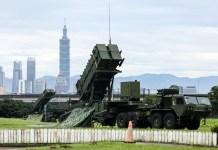China’s People’s Liberation Army (PLA) soldiers are using unorthodox electronic aids in an attempt to improve muscle and reflexive memory.
Photos of what is described as electric ‘pain pads’ are said to send a mild electric shock when a soldier breaks good shooting posture in stressful situations.
Indian military veterans believe its benefits are exaggerated but appreciate the need to introduce more modern technology that targets cognitive abilities in infantry training.
Shocks, Distraction To Maintain Correct Posture
A photo on Twitter by the popular Chinese handle Zhao DaShuai (@zhao_dashuai) showed two PLA soldiers wearing white patches above their left wrists while undergoing shooting drills. One soldier is firing a squad light machine gun on the tripod, and the other is firing the standard QBZ-95 bullpup assault rifle.
The description by @zhao_dashuai called the patches “electric pain pads” meant to “shock the soldier periodically to ensure they maintain a good shooting posture even under stressful situations.”
The handle responded to a comment in the thread that objected to the punitive orientation of the system to enforce the correct behavior. He said it was not “negative reinforcement training but done as a distraction and hindrance.”
“PLA soldiers regularly train to shoot with distractions. It’s either this or having all sorts of bugs on your face while shooting,” he replied. Shooting drills with distractions involve loud noises or objects that cause a soldier to break focus when firing in warlike chaotic situations.
PLA soldiers training with electric "pain pads"
It shocks them periodically, to make sure they maintain good shooting posture even under stressful situations pic.twitter.com/X5Ey7CTfpv
— Zhao DaShuai 无条件爱国?? (@zhao_dashuai) January 14, 2023
It is unclear whether the PLA soldiers are special operations units or regular infantry since even the latter sometimes have advanced gear like night vision goggles and ballistic high-cut helmets. It is also unknown whether the pads’ current is sent automatically, manually, or through an external operator when the soldiers break shooting form/posture.
Veterans Speak
A serving officer commanding an Indian Army’s infantry Division said the pad has a diminishing utility when used for a prolonged period.
“It will distract the soldier for a while, after which the soldier will be able to focus and fire,” he said. This means that the brain adapts to the stimuli after extended exposure and stops reacting to them, and the soldier’s concentration will become resistant to the distractions and the ‘shocks.’
“Moreover, this is only a small distraction since there are several other loud noises and flashes in actual combat like shelling, bullets whizzing past your heads, and weather conditions,” he said.
The Indian Major General admitted that soldiers need to be exposed to such devices for a different experience and to add an element of novelty to the training.
Colonel Parmesh K. Mehrishi (retd), who was in the Sikh Light Infantry, called it a “gimmick” unless it is known what are the other features of the shooting range.
“A good shooting range is the one that reproduces battlefield-like realistic combat situations. It should replicate obscured visibility, moving targets, and time and ammunition constraints to engage all targets in various positions (standing, lying, or kneeling). The goal should be quick identification and response by the firer,” Mehrishi said.
Mehrishi had led the design and construction of a shooting drill during his service that met the above criteria.
Captain Suresh Babu (retd), who was an Indian Navy Marine Commando (MARCOS), called the pads “wonderfully innovative” but can become “terribly unnerving” later.
Babu adds that MARCOS exercises are punishing, putting operators through an obstacle course and then carrying out firing, which increases the degree of difficulty.
The objective is to get the operators used to the fact they would be shooting at enemies, usually after being exhausted. This is following hiking, swimming, or running for miles and not when they would be at the peak of their physical and mental abilities before energy depletion.
How Will China Fight Its War?
In the final analysis, China appears to be advancing rapidly technologically as well as in human skill, but the outcome of a war depends on many other factors, and such gimmicks are usually a part of a publicity effort by rising powers.
It could very well be aimed at the American military, which has faced a personnel management problem with its soldiers and veterans.
As for comparing Indian and Chinese infantry, Mehrishi said that Indian Army troops are far “hardy, robust” and conditioned physically and mentally than Chinese soldiers. But it again comes down to what kind of war the two countries will fight and how long it lasts.
China will prefer to prevent war and operate in the grey zone to the fullest extent since it is far more invested in stability to protect its infrastructural and industrial investments of the Belt and Road Initiative (BRI) in the continent.
It will therefore conduct the war in a way that would disallow the Indian military the time and window to exploit its strengths and wrap the war on its terms. The smart way is not to fight the enemy’s war but make it fight yours the way you want.
- The author can be reached at satamp@gmail.com
- Follow EurAsian Times on Google News




